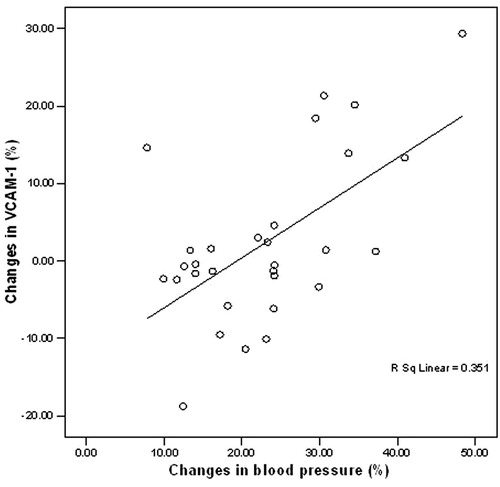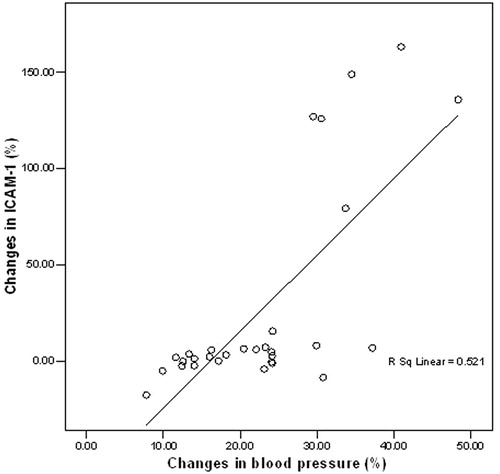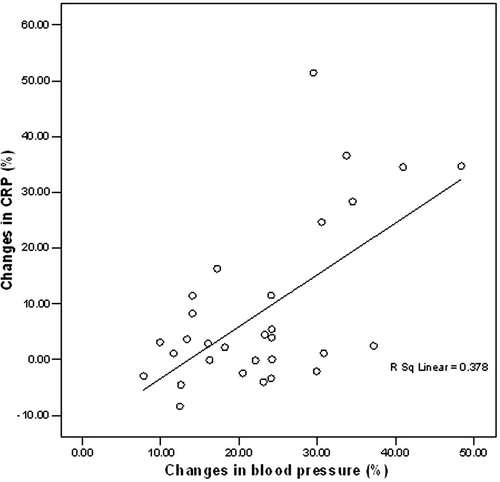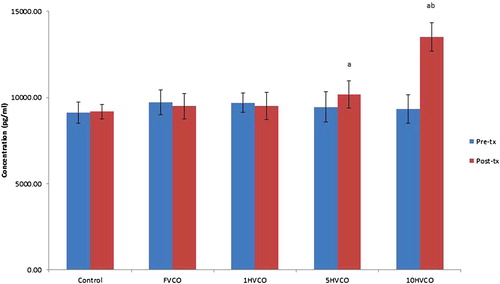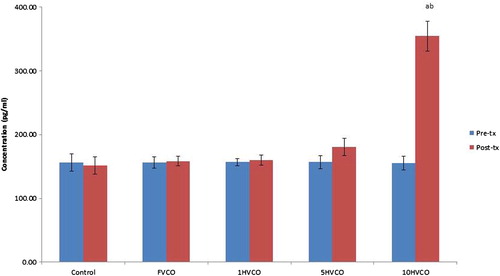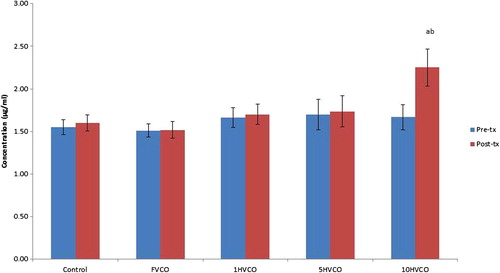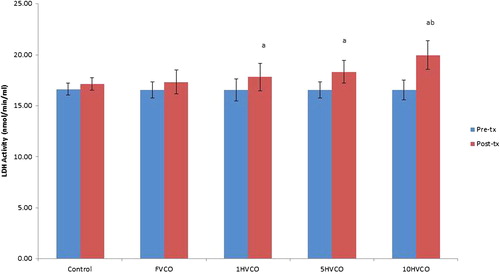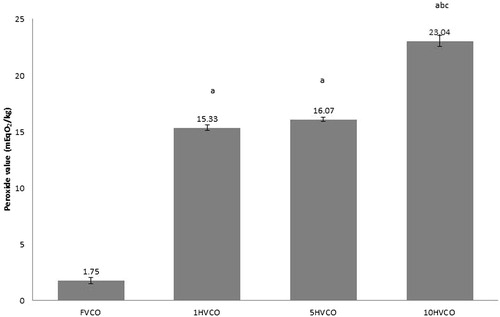 ?Mathematical formulae have been encoded as MathML and are displayed in this HTML version using MathJax in order to improve their display. Uncheck the box to turn MathJax off. This feature requires Javascript. Click on a formula to zoom.
?Mathematical formulae have been encoded as MathML and are displayed in this HTML version using MathJax in order to improve their display. Uncheck the box to turn MathJax off. This feature requires Javascript. Click on a formula to zoom.Abstract
Background
It is a common practice to heat cooking oil and reuse it in order to cut expenses. The use of repeatedly heated cooking oil predisposes to various cardiovascular diseases. Virgin coconut oil (VCO) is reported to possess antioxidant action.
Aim
The study aimed to determine the effect of heating of VCO on the blood pressure (BP) and inflammatory bio-markers.
Methods
Thirty male Sprague-Dawley rats were divided into five groups and were fed with the following diet for 24 weeks: normal rat chow (control); chow + fresh VCO (FVCO); chow + VCO heated once (1HVCO); chow + VCO heated five times (5HVCO) and chow + VCO heated ten times (10HVCO). BP was measured at baseline and four weekly for 24 weeks. Blood was collected at baseline and at the end of study to measure plasma TXB2, PGI2, VCAM-1, ICAM-1 and LDH enzyme activity.
Results
BP increased significantly in the 5HVCO and 10HVCO groups compared to the control and FVCO groups. The 5HVCO and 10HVCO diet caused a significant increase in the plasma TXB2 and a significant decrease in the plasma PGI2 level. The plasma levels of VCAM-1, ICAM-1 and CRP were significantly increased in the 10HVCO group.
Conclusion
Repeatedly heated VCO caused an elevation in the BP. The BP elevation was associated with a significant increase in the inflammatory bio-markers (VCAM-1, ICAM-1 and CRP), TXB2 and a significant reduction in the plasma PGI2 level.
1 Introduction
Cooking oils possess different fatty acid composition. Soy oil contains 60% polyunsaturated fatty acids (PUFA), 24% monounsaturated fatty acids (MUFA) and 16% saturated fatty acids (SFA). In contrast, palm oil contains 50% MUFA, 50% SFA. Soy oil is rich in tocopherol, whilst palm oil is rich in tocotrienols. Both possess antioxidant properties that act as free radical scavengers.Citation1 Tocotrienols have greater antioxidant properties compared to the tocopherols.Citation2
Coconut (Cocos nucifera) is a fruit which is abundant in the tropical and subtropical countries such as Philippines, Malaysia, Indonesia and India. Over the past ten decades, coconut products have been used either as a food or medication.Citation3 There is extensive research on coconut oil in order to explore its potential uses. Coconut oil is used as edible oil for domestic consumption. Several methods are employed to extract the coconut oil, which involve either dry or wet processing. In dry processing, the coconut oil is extracted from the copra i.e. the dried kernel. The oil then undergoes the process of refining, bleaching and deodorizing (RBD) which involves chemicals and heating at a high temperature.
Virgin coconut oil (VCO) may be defined as the oil which is obtained from the fresh and mature kernel of the coconut by mechanical or natural means with or without the use of heat and without subjecting it to any chemical RBD process.Citation4 Hence, the process to extract VCO is also known as the wet extraction method. The fatty acid contents of the VCO, are mainly medium chain saturated fatty acid (MCFA) (50%); lauric acid, short chain saturated fatty acids (SCFA) such as capric, caproic and caprylic acid and unsaturated fatty acids (8%).Citation5 The advantage of the wet extraction method is due to the fact that the oil retains more biologically active components such as tocotrienols, polyphenols and tocopherols, that possess the antioxidant properties.Citation4,Citation6 Instead of being consumed as cooking oil, VCO is considered as a functional food supplement. Other than the antioxidant properties, VCO has been reported to have antibacterial, antiviral, antinociceptive, and anti-inflammatory and lipid lowering effect.Citation7–Citation8Citation9Citation10
Soy oil and palm oil are commonly used for deep frying. However, it has been a common practice to heat the oil repeatedly, in order to save the cost. The oil is discarded only if the physical appearance of the oil deteriorates.Citation11 It has been documented that consumption of repeatedly heated palm oil causes an increase in the blood pressure (BP) and impaired endothelium-dependent vascular relaxation.Citation12 Previous study has shown that consumption of repeatedly heated soy oil was predisposed to atherosclerosis.Citation1 Inflammation and oxidative stress are attributed to the pathogenesis of hypertension and atherosclerosis.Citation12 Hypertension is related to the disturbance of homoeostasis of thromboxane A2 (TXA2) and prostacyclin (PGI2).Citation13 The two oxygenated metabolites of arachidonic acid have potent and contrasting effects on vascular tone and platelet function.Citation13 Inflammation has been implicated in pathogenesis of atherosclerosis and has been shown to be associated with an increase in inflammatory biomarkers such as an increase in the level of C-reactive protein (CRP), vascular cell adhesion molecule (VCAM-1) and intercellular adhesion molecule (ICAM-1).Citation14 Elevation in the lactate dehydrogenase (LDH) enzyme activity also indicates the disturbance in the normal functioning of the heart.Citation15
VCO is gaining popularity as cooking oil in the society. The present study aimed to determine the effect of heated VCO on blood pressure and inflammatory biomarkers. To the best of our knowledge, this may be the first study of its kind. We postulated that VCO being rich in heat stable antioxidant may have no detrimental effect on BP and related biomarkers. Hence, it may be consumed as frying edible oil in future.
2 Methods
2.1 Animals and study design
A total of thirty adult male Sprague-Dawley rats aged 3 months (weighing 200–280 gm) were obtained from an Animal House of Universiti Kebangsaan Malaysia. Ethical approval was obtained from University Animal Ethics Committee prior to the study (Permit No. PP/ANAT/2011/SRIJIT/19-MAY/370-MAY-2011-AUGUST-2012). The animals were managed and procedures were performed as per the recommended guidelines. The rats were kept in plastic cages and maintained at room temperature of 25 ± 2 °C with a 12 h light–dark cycle. The rats were allowed to acclimatize for 1 week prior to study with the test diet. All rats had free access to food and water ad libitum during the study period.Citation16 The rats were randomly divided into five groups comprising six animals per group. Following 1 week of acclimatization, the following diets were fed to each group of rats: group I (control) was fed only with commercial rat chow (basal diet); group II was fed with basal diet fortified with 15% weight/weight (w/w) of fresh VCO (FVCO); group III was fed with basal diet fortified with VCO heated once (1HVCO); group IV was fed with basal diet fortified with VCO heated five times (5HVCO) and group V was fed with basal diet fortified with VCO heated ten times (10HVCO) for 24 weeks. BP was measured at baseline and at intervals of 4 weeks for 24 weeks using a non-invasive method. Blood was collected through the orbital sinus prior to the treatment, and at the end of study. The blood was then centrifuged to obtain plasma for the biochemical analysis.
2.2 Preparation of oil diet
VCO used for this study was purchased from local manufacturer Organic Gain Sdn Bhd (Bangi, Selangor, Malaysia). It was used either in a fresh form, heated once, five times or ten times as per earlier protocol described by Owu et al. with few modifications.Citation17 Briefly, 2.5 L of oil was heated to 180 °C in a stainless steel wok and used to deep-fry 1 kg sliced sweet potatoes. The heating process lasted for 15 min. The hot oil was then left to cool at room temperature for 5 h. This procedure resulted in the once heated VCO group (1HVCO). The pre-cooled hot oil was used to deep-fry another new batch of sweet potatoes. The frying process was carried out without adding any fresh oil to compensate for oil losses. In order to obtain VCO heated five times (5HVCO) and VCO heated ten times (10HVCO), the same heating procedure was repeated four and nine times, respectively. The experimental diets were prepared twice in a week. Standard rat chow (Gold Coin, Port Klang, Selangor, Malaysia) was ground and mixed with some water and fresh or the heated VCO prepared. The weight ratio of rat chow to the oil was 100:15. The mixture was then dried at 70 °C overnight in an oven.
2.3 Measurement of blood pressure
Systolic blood pressure (SBP) of pre-warmed conscious rats was measured by the non-invasive tail cuff method using PowerLab data acquisition systems (ADInstruments, Castle Hill, NSW, Australia). Minimum five measurements were recorded and the mean SBP was used in further analysis.Citation16
2.4 Measurement of plasma TXB2 and PGI2
The plasma TXB2 and PGI2 were measured using commercially available ELISA kit (Cusabio, USA) according to the manufacturer’s instruction.Citation13,Citation18 The intensity of coloured product was measured at absorbance 450 nm in a micro plate reader (VERSA, USA). The result was calibrated by the software calculation that was provided with the micro plate reader and compared to the calibration standard curve.
2.5 Measurement of plasma VCAM-1 and ICAM-1
The quantification of soluble VCAM-1 and soluble ICAM-1 was determined using commercially available ELISA kit from USCN Life Science Inc. (Wuhan, China) and Abnova (Taipei, Taiwan), respectively following manufacturer’s instruction.Citation14 Absorbance at 450 nm was determined using VERSA micro plate reader (USA). Values of samples were calculated by the software provided with the micro plate reader and compared to the standard curve generated.
2.6 Measurement of plasma CRP
The plasma of CRP was determined using commercially available ELISA kit (Abnova, Taipei, Taiwan) in accordance with the manufacturer’s instruction.Citation14 The intensity of coloured product was measured using VERSA micro plate reader (USA) at 450 nm absorbance. Values of samples were calculated by the software provided with the micro plate reader and compared with the standard curve generated.
2.7 Measurement of plasma LDH
The activity of LDH was determined using commercially available kit (BioVision, USA).Citation19 The standards and samples were prepared following manufacturer’s instruction. The intensity of coloured product (NADH) was measured using VERSA micro plate reader (USA) at 450 nm. OD 450 nm was measured to read A1 and incubated at 37 °C for 30 min. Following the incubation OD 450 nm was measured again to read A2. The standard curve was generated using the A2 reading after subtracting the blank reading. Values of NADH at A1 and A2 were calculated from the standard curve, and the LDH activity calculation was based on the manufacturer’s instruction:
B was the NADH amount that was generated between T1 and T2 (Value A2 – Value A1) in nmol.
T1 was the time for first reading (A1) in min.
T2 was the time for second reading (A2) in min.
V was the pre-treated sample volume added into the reaction well (in ml).
Unit definition: One unit LDH was the amount of enzyme that catalysed the conversion of lactate to pyruvate to generate 1.0 μmol to NADH per minute at 37 °C.
2.8 Measurement of peroxide value (PV)
The PV of VCO was determined using the standard titration method (Official method Cd 8-53) as described by the American Oil Chemists’ Society (AOCS). The peroxide value was expressed as mille-equivalents of active oxygen per kilogram of oil sample (mEq O2/kg).
2.9 Statistical analysis
The data was presented as the mean ± standard error of mean (SEM). The normality of all the data was first determined by Kolmogorov–Smirnov test. Statistical differences were determined using paired student’s t-test, or one-way analysis of variance (ANOVA) followed by Tukey HSD post hoc test. Data that were not normally distributed were analysed using non-parametric tests, i.e. Wilcoxon-Signed-Rank test or Kruskal–Wallis test. A value of p < 0.05 was considered to be significant. All analyses were performed using SPSS software version 20.0 (SPSS Inc., Chicago, USA).
3 Results
3.1 Food intake and body weight
The oil fed groups (FVCO, 1HVCO, 5HVCO and 10HVCO) showed a significant (p < 0.05) lower food intake compared to the control group (). Nevertheless, all groups showed a significant increase in the body weight at the end of study period compared to respective baseline value (p < 0.05). Body weight in 1HVCO, 5HVCO and 10HVCO groups was significantly higher compared to control and FVCO groups (p < 0.05) ().
Figure 1 Food intake and body weight gain of rats fed with respective diets after 24 weeks. Normal rat chow (control), fresh VCO (FVCO), VCO heated once (1HVCO), VCO heated five times (5HVCO) or VCO heated ten times (10HVCO) after 24 weeks of feeding. Data are shown as means ± SEM (n = 6). ‘a’ is significant difference compared to control groups (p < 0.05).
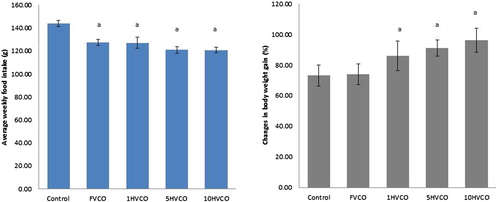
3.2 Blood pressure
At the end of 24-week feeding period, there was a significant increase in the BP (p < 0.05) in 5HVCO and 10HVCO groups compared to the control and FVCO groups. There were no significant changes in BP in the control, FVCO and 1HVCO ().
Figure 2 Effects of fresh and heated VCO on blood pressure in adult male rats. Shown are the blood pressure changes in rats fed with normal rat chow (control), FVCO, 1HVCO, 5HVCO or 10HVCO after 24 weeks of feeding. Data are shown as means ± SEM (n = 6). ‘a’ is significant difference between pre- and post-treatment values for the same group (p < 0.05). ‘b’ is significant difference compared to control and FVCO groups (p < 0.05).
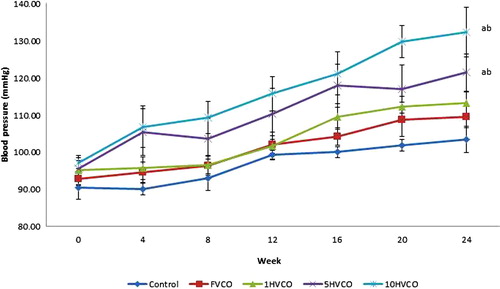
3.3 Plasma TXB2
There was a significant increase (p < 0.05) in the TXB2 level in the 5HVCO and 10HVCO groups compared to the control. The increase in the TXB2 level in 10HVCO was significantly higher (p < 0.05) compared to the other groups. However, there were no significant changes in the TXB2 level in the control, FVCO and 1HVCO groups ().
3.4 Plasma PGI2
There was a significant decrease in PGI2 (p < 0.05) in the 5HVCO and 10HVCO groups compared to respective baseline value. The level of PGI2 in the 10HVCO group was significantly lower (p < 0.05) compared to the rest of the groups. However, there was no significant difference in PGI2 in the control, FVCO and 1HVCO groups compared to the respective baseline ().
Figure 4 Determination level of PGl2 in the pre-treatment and post-treatment in the different groups. ‘a’ is significant difference between pre- and post-treatment values for the same group (p < 0.05). ‘b’ is significant difference compared to FVCO and 1HVCO group (p < 0.05). ‘c’ is significant difference compared to other groups (p < 0.05).
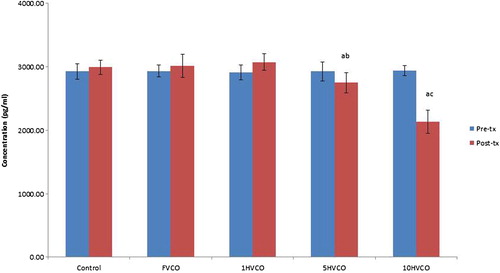
3.5 Plasma VCAM-1
There was no significant difference in VCAM-1 level between the pre-treatment and post-treatment in the control, 1HVCO and 5HVCO groups. There was a significant (p < 0.05) decrease in the level of VCAM-1 in the FVCO compared to the baseline. In contrast, there was a significant increase in the VCAM-1 level in the 10HVCO group (p < 0.05) compared to the other groups ().
3.6 Plasma ICAM-1
There was no significant difference in ICAM-1 level before and after the study in all groups except for the 10HVCO group. However, there was a significant increase in ICAM-1 (p < 0.05) in the 10HVCO group compared to the rest of the groups ().
3.7 Plasma CRP
There was a significant increase in CRP level (p < 0.05) in the 10HVCO group compared to baseline and all other groups ().
3.8 Plasma LDH activities
There was no significant change in the LDH activity in the control and FVCO groups. However, there was a significant increase in LDH activity in the 1HVCO, 5HVCO and 10HVCO compared to baseline value ().
3.9 Correlation between the inflammatory markers and blood pressure
There was a strong significant positive relationship between VCAM-1, ICAM-1, CRP and TXB2 with BP. This suggests that elevation in the blood pressure in this study may be a consequence of vascular inflammation as reflected by an increase in VCAM-1, ICAM-1 and CRP in the circulation. The vascular inflammation subsequently impaired production of TXB2 by vascular endothelium leading to an increase in the BP. In contrast, there was a negative relationship between PGI2 and BP. This suggests that the reduction of PGI2 in the circulation may contribute to the elevation of BP (–).
3.10 Peroxide value
VCO has lower PV value. However, PV value increases significantly (p < 0.05) once the VCO was heated. The PV of 1HVCO, 5HVCO and 10HVCO samples was significantly higher when compared to the PV of FVCO ().
4 Discussion
In the present study, there was a significant increase in body weight of all groups compared to their respective baseline values. In spite of lower food intake the body weight increment was more in the 1HVCO, 5HVCO and 10HVCO groups compared to the control and FVCO groups. The weight gain for the FVCO fed group was lower compared to the control group. This finding suggests that consumption of FVCO did not lead to abnormal weight gain despite high saturated fatty acid content. The saturated fatty acids in VCO consist of medium chain fatty acids (MCFA) that are made up of 8–10 carbons. MCFA has different characteristics compared to long-chain fatty acids (LCFA) in terms of digestion, absorption, biodegradation and body-fat accumulation.Citation20
MCFA is easily digested and absorbed compared to the LCFA. MCFA is directly absorbed into circulation and delivered to the liver, where it was metabolized faster into energy. Thus, it prevents body-fat accumulation.Citation20 The result of the present study was similar to earlier results. In contrast, we observed that the rats fed with 1HVCO, 5HVCO and 10HVCO had significantly higher weight gain compared to the control and FVCO groups. This finding suggests that consumption of heated VCO may lead to overweight, which is one of the risk factors for cardiovascular disease. This finding was in line with earlier studies which showed that animals that consumed repeatedly heated palm oil and soy oil exhibited greater body weight gain compared to the control group.Citation12,Citation21
Few studies observed that polyunsaturated fatty acids (PUFAs) were relatively unstable compared to the saturated fatty acids (SFAs).Citation22,Citation23 PUFA was more susceptible to oxidation that leads to lipid peroxidation and oxidative stress. Previous studies reported that consumption of repeatedly heated cooking oil increased BP.Citation12,Citation16,Citation24 The BP raising effect of heated oils was attributable to oxidative stress.Citation12,Citation16,Citation24 VCO being high in SFA would be more stable for usage as frying oil. Previous study reported that VCO has relatively high oxidative stability similar to the extra-virgin olive oil (EVOO) and palm olein.Citation22,Citation23 Unexpectedly we observed that repeatedly heated VCO causes BP elevation in spite of low oxidation index compared to the palm oil and olive oil.Citation22,Citation23
However, we noted that FVCO and 1HVCO did not cause significant increase in BP. In the present study, the increase in BP in 5HVCO and 10HVCO groups was associated with a significant increase in the plasma, ICAM, VCAM, CRP and TXB2 levels and a significant decrease in PGI2. The strong positive correlation between BP changes with ICAM, VCAM, CRP and TXB2 suggesting that vascular inflammation may play an important role in BP raising effect of VCO. TXA2 is a potent pro-aggregator and vasoconstrictor prostanoid. It is produced and released by the platelets during aggregation and is rapidly metabolized to its stable breakdown product, thromboxane B2 (TXB2)Citation25 whilst PGI2 produce vasodilation. The homoeostasis of TXA2 and PGI2 is crucial for the BP regulation. Our finding was similar to previous studies which reported that the release of TXB2 and prostacyclin were increases and decreases, respectively in the hypertensive rats.Citation26,Citation27 Ng et al. reported that the increase in BP with heated oil was associated with an increase in the TXA2/PGI2 ratio.Citation28 Again, this abnormality may be due to the abnormal platelet functions which is source of TXA2 and PGI2.Citation29
We postulated that repeatedly heated VCO produced oxidative stress that causes endothelial vascular inflammation which may interfere with the release of vasoactive substance such as thromboxane (TXB2) and prostacyclin (PGI2). The thermal oxidation occurring during repeatedly heating of the oil generates reactive oxygen species (ROS) which cause damage to the cells. This ROS is considered to be a major cause of endothelial dysfunction and vascular inflammation.Citation30 VCAM-1 and ICAM-1 are adhesion molecules involved in the rolling, adhesion and extravasation of leukocytes, mainly mononuclear cells to the inflammation site.Citation14 The upregulation of these adhesion molecules is accompanied by the release of its soluble fraction into the bloodstream. The increased expression of VCAM-1 and ICAM-1 and CRP is a common process in inflammation. Few studies reported a strong positive correlation between the VCAM-1 and ICAM expression and BP in repeatedly heated cooking oil.Citation31,Citation32 These three inflammatory biomarkers have been identified as risk factors for cardiovascular disease such as hypertension and atherosclerosis.Citation14,Citation33,Citation34
In the present study, the LDH activity was increased in the 1HVCO, 5HVCO and 10HVCO groups, which may suggest that heated VCO may cause tissue damage. LDH activity has been reported to be abnormal in a large number of disorders.Citation35 Although, the increase in LDH activity is non-specific, the tissue damages may be due to inflammation caused by the ROS that was generated by the thermal oxidation of repeatedly heating the oil, and this caused the endothelial cell injury.Citation35 Considering the findings from previous studies, it is clear that consumption of repeatedly heated cooking oil is one of the risk factors for the development of cardiovascular diseases.Citation1,Citation12,Citation16,Citation31 Our findings on repeatedly heated VCO were in accordance with earlier findings, which reported that heated oil increases blood pressure. However, in the present study the BP raising effect of heated VCO was only noted in 5HVCO and 10HVCO groups. Our finding was in contrast to previous studies which reported that heated once soy, two times, five times and ten times palm oil increase blood pressure. These findings may suggest that the heated VCO appears to be more stable compared to heated palm and soy oil as only 5HVCO and 10HVCO increased the BP. The scientific reason behind this fact is not well understood and needs further exploration. There is a possibility that the high concentration of heat stable antioxidant such as polyphenols in VCO may protect the thermal oxidation of the oil and prevent from free radical induced injury such as hypertension. Therefore, it is recommended not to heat the VCO repeatedly, as it may destroy antioxidants as reflected by an increase in PV of heated VCO.
In this study, we used sweet potato as a common vehicle for preparing repeatedly heated frying oil. This was in accordance with a previous study which used sweet potato for frying.Citation36 Reason for using sweet potato in this study is because we do not want the fried food such as fish or meat to interfere with the oil’s peroxide value.Citation37
There were few limitations which were encountered. Admittedly, we did not make an adjustment for the food intake for the difference in body weight gain among the groups. Secondly, the best method to measure VCAM and ICAM was by immunohistochemistry using blood vessel rather than the soluble form. Thirdly the increase in BP should have been adjusted for body weight gain, and other potential factors.
Further studies are needed to elucidate the possible mechanism of the BP raising effect of VCO. Studies reported that consumption of fresh VCO has a beneficial role in improving antioxidant status and preventing lipid and protein abnormality.Citation38 The present findings also showed that consumption of fresh VCO did not produce detrimental effect on blood pressure, inflammatory biomarkers and helped to reduce body weight. Hence, it may be suggested that consumption of fresh VCO has a potential role in preventing cardiovascular diseases. It is always beneficial to follow official methods and recommended practices for heating oils.Citation39
5 Conclusion
In conclusion, fresh VCO has no detrimental effect on blood pressure, inflammatory biomarkers and helps to reduce body weight in test animals. Repeatedly heated VCO increases BP and inflammatory biomarkers just like heated palm and soy oil. Therefore, VCO is more suitable to be consumed in a fresh form for health benefit.
Conflict of interest
None of the authors have any conflict of interest to declare.
Acknowledgement
The authors acknowledge the financial support received from Universiti Kebangsaan Malaysia (UKM-FF-03-FRGS0222-2010). The authors also thank the supporting staff members of Anatomy and Pharmacology department for all technical help.
Notes
Peer review under responsibility of Alexandria University Faculty of Medicine.
Available online 27 March 2014
References
- S.K.AdamS.DasO.FaizahK.JaarinFresh soy oil protects against vascular changes in an estrogen-deficient rat model: an electron microscopy studyClinics64200911131119
- X.F.LeongJ.SalimonM.R.MustafaK.JaarinEffect of repeatedly heated palm olein on blood pressure – regulating enzymes activity and lipid peroxidation in ratsMalays J Med Sci1920112029
- M.DebMandalS.MandalCoconut (Cocos nucifera L.: Arecaceae): in health promotion and disease preventionAsian Pacific J Trop Med42011241247
- A.M.MarinaY.B.Che ManI.AminVirgin coconut oil: emerging functional food oilTrends Food Sci Tech202009481487
- O.O.DosumuO.DuruA.A.FIA.A.OsinubiInfluence of virgin coconut oil (VCNO) on oxidative stress, serum testosterone and gonadotropic hormones (FSH, LH) in chronic ethanol ingestionAgric Biol J North Am1201011261132
- K.G.NevinT.RajamohanVirgin coconut oil supplemented diet increases the antioxidant status in ratsFood Chem992006260266
- B.J.VillarinoL.M.DyM.C.C.LizadaDescriptive sensory evaluation of virgin coconut oil and refined, bleached and deodorized coconut oilLWT Food Sci Technol402007193199
- Z.A.ZakariaM.N.SomchitA.M.Mat JaisL.K.TehM.Z.SallehK.LongIn vivo antinociceptive and anti-inflammatory activities of dried and fermented processed virgin coconut oilMed Princ Pract202011231236
- Z.A.ZakariaM.S.RofieeM.N.SomchitHepatoprotective activity of dried- and fermented-processed virgin coconut oilEvid Based Complement Altern Med23201114273910.1155/2011/142739
- K.G.NevinT.RajamohanInfluence of virgin coconut oil on blood coagulation factors, lipid levels and LDL oxidation in cholesterol fed Sprague-Dawley ratsClin Nutr Metab32008e1e8
- A.AzmanS.Mohd ShahrulS.X.ChanLevel of knowledge, attitude and practice of night market food outlet operators in Kuala Lumpur regarding the usage of repeatedly heated cooking oilMed J Malays67201191101
- X.F.LeongM.N.NajibS.DasM.R.MustafaK.JaarinIntake of repeatedly heated palm oil causes elevation in blood pressure with impaired vasorelaxation in ratsTohoku J Exp Med21920097178
- G.A.FitzgeraldA.K.PedersenC.PatronoAnalysis of prostacyclin and thromboxane biosynthesis in cardiovascular diseaseCirculation67198311741177
- A.A.AmranZ.ZakariaO.FaizahS.DasA.M.M.HeshamChanges in the vascular cell adhesion molecule-1, intercellular adhesion molecule-1 and c-reactive protein following administration of aqueous extract of piper sarmentosum on experimental rabbits fed with cholesterol dietLipids Health Dis1020112
- M.RisenforsM.HartfordM.DellborgR.LuepkerA.HjalmarssonK.SwedbergEffect of early intravenous rt-PA on infarct size estimated from serum enzyme activity: results from the TEAHAT studyJ Intern Med Suppl73419911118
- X.F.LeongM.R.MustafaS.DasK.JaarinAssociation of elevated blood pressure and impaired vasorelaxation in experimental Sprague-Dawley rats fed with heated vegetable oilLipids Health Dis9201066
- D.U.OwuE.E.OsimP.E.EbongSerum liver enzymes profile of Wistar rats following chronic consumption of fresh or oxidized palm oil dietsActa Trop6919986573
- S.K.JainK.S.KruegerR.M.VieJ.J.JaramilloM.PalmerT.SmithRelationship of blood thromboxane-B2 (TxB2) with lipid peroxides and effect of vitamin E and placebo supplementation on TxB2 and lipid peroxide levels in type 1 diabetic patientsDiabetes Care21199815111516
- L.C.EdeJ.O’BrienT.ChonmaitreeY.HanJ.A.PatelLactate dehydrogenase as a marker of nasopharyngeal inflammatory injury during viral upper respiratory infection: implications for acute otitis mediaPediatr Res732013349354
- H.TakeuchiS.SekineK.KojimaT.AoyamaThe application of medium-chain fatty acids: edible oil with a suppressing effect on body fat accumulationAsia Pac J Clin Nutr172008320323
- S.K.AdamS.DasS.Ima NirwanaN.A.UmarK.JaarinConsumption of repeatedly heated soy oil increases the serum parameters related to atherosclerosis in ovariectomized ratsTohoku J Exp Med2152008219226
- F.S.Henna LuP.P.TanA Comparative study of storage stability in virgin coconut oil and extra virgin Olive oil upon thermal treatmentInt Food Res J162009343354
- H.M.GhazaliA.TanS.M.AbdulkarimM.H.DzulkiflyOxidative stability of virgin coconut oil compared with RBD palm olein in deep-fat frying of fish crackersJ Food Agric Environ720092337
- F.SoriguerG.R.MartínezM.C.DobarganesHypertension is related to the degradation of dietary frying oilsAm J Clin Nutr78200310921097
- M.HambergJ.SvenssonB.SamuelssonThromboxanes: a new group of biologically active compounds derived from prostaglandin endoperoxidesProc Natl Acad Sci USA72197529942998
- T.OgoH.M.ChowdhuryJ.YangInhibition of overactive transforming growth factor-β signaling by prostacyclin analogs in pulmonary arterial hypertensionAm J Respir Cell Mol Biol482013733741
- G.BergmanL.AtkinsonP.J.RichardsonProstacyclin: haemodynamic and metabolic effects in patients with coronary artery diseaseLancet11981569572
- C.Y.NgY.KamisahF.OthmanK.JaarinThe role of repeatedly heated soybean oil in the development of hypertension in rats: association with vascular inflammationInt J Expert Pathol932012377387
- C.ChackoT.RajamohanRepeatedly heated cooking oils alter platelet functions in cholesterol fed Sprague dawley ratsInt J Biol Med Res22011991997
- D.G.HarrisonM.C.GongoraT.J.GuzikJ.WidderOxidative stress and hypertensionJ Am Soc Hypertens120073044
- C.Y.NgY.KamisahO.FaizahJ.ZakiahH.M.S.QodriyahK.JaarinInvolvement of inflammation and adverse vascular remodelling in the blood pressure raising effect of repeatedly heated palm oil in ratsInt J Vasc Med23201240402510.1155/2012/404025
- S.KomatsuJ.PanesJ.M.RussellEffects of chronic arterial hypertension on constitutive and induced intercellular adhesion molecule-1 expression in vivoHypertension291997683689
- H.D.SessoJ.E.BuringN.RifaiC-reactive protein and the risk of developing hypertensionJAMA290200329452951
- J.K.PaiT.PischonJ.MaInflammatory markers and the risk of coronary heart disease in men and womenNEJM351200425992610
- M.DrentN.A.CobbenR.F.HendersonE.F.WoutersM.V.D.VisserUsefulness of lactate dehydrogenase and its isoenzymes as indicators of lung damage or inflammationEur Respir J9199617361742
- K.JaarinM.R.MustafhaX.F.LeongThe effects of heated vegetable oils on blood pressure in ratsClinics (Sao Paulo)66201121252132
- Y.KamisahS.ShamilM.J.NabillahS.Y.KongN.A.HamizahH.M.S.QodriyahDeep-fried keropok lekors increase oxidative instability in cooking oilsMalays J Med Sci420125762
- S.ArunimaT.RajamohanEffect of virgin coconut oil enriched diet on the antioxidant status and paraoxonase 1 activity in ameliorating the oxidative stress in rats – a comparative studyFood Funct4201314021409
- AOCSOfficial Methods and Recommended Practices of the American Oil Chemists’ Society4th ed.2003AOCS PressUSA

